Swords and Silver Rings:
Objects and Expression in Magical Realism and the New World Baroque
Intro | Section 1 | Section 2 | Section 3 | Notes
Section Three: García Márquez's Baroque Objects
Household objects, in the fullness of their poetry, flew with their own wings throught the kitchen sky.
Gabriel García Márquez
Whereas Borges explicitly addresses the visualizing capacity of language within his fictions, García Márquez does not, preferring to leave his readers wondering whether or not to believe our eyes. Whereas the idealist Borges refuses the magical content of real objects, preferring to locate his magic in "secondary," Platonic "poetic objects," García Márquez's more realistic aesthetic allows for a visible world in which magic does indeed "hide and palpitate" behind the real (to use Franz Roh's phase once again). We have only to consider the ice and the magnets at the beginning of One Hundred Years of Solitude to find perfect Franz Roh-ian objects. These objects--the ice, the magnets--are described as magical, and are endowed with inner lives. The ice mentioned in the justly famous first sentence of the novel is later described as ". . . an enormous, transparent block with infinite internal needles in which the light of the sunset was broken up into colored stars." (18) And when José Aracadio becomes overly enthusiastic about the magical capacity of Melquíades' magnets, with which he hopes ". . . to extract gold from the bowels of the earth," Melquíades calms him down by assuring him that "Things have a life of their own. . . . It's simply a matter of waking up their souls." (11) Franz Roh could not have put it better. Macondo is filled with wonderment, and it is often contained in, and expressed by particular, material objects.
But unlike the painted objects of the Post-Expressionists, which I have quoted Franz Roh as calling "enigmas of quietude in the midst of general becoming" (22), García Márquez's verbal objects are anything but quiet. The exuberant enumeration of material objects gives to García Márquez's fictional world a Baroque texture that is sensuous, ornate, dynamic, theatrical. Richness of narrative detail on an immense scale characterizes One Hundred Years of Solitude, The Autumn of the Patriarch, Love in the Time of Cholera, and it is this profusion of things, I am arguing, that gives to his novels their magical substratum. Countless examples could be offered, but here I will give only one, a favorite passages of mine from Love in the Time of Cholera, where Fermina Daza finds herself in the Arcade of the Scribes--"a place", we are told, "of perdition that was forbidden to decent young ladies." Fermina nonetheless directs her steps to the Arcade: quote: "into the hot clamor of the shoeshine boys and the bird sellers, the hawkers of cheap books and the witch doctors and the sellers of sweets . . . " (101). Her attention is drawn by a paper seller hawking "magic ink," and after considering a rainbow of colors she decides on a bottle of gold ink to write her love letters to Florentino, whereupon she proceeds to the stalls of the candy sellers and chooses six of every kind of candy--"six angel hair, six tinned milk, six sesame seed bars, six cassava pastries, six chocolate bars, six blancmanges, six tidbits of the queen, six of this and six of that, six of everything" (101)--until the colors and smells and tastes and sheer variety are said to cast a spell upon her. In these two paragraphs chock full of specific naming, and throughout García Márquez's work, such proliferating objects cast spells--ice, magnets, the tapestries so real that the hens peck at the embroidered plants, the political enemy served for dinner like a suckling pig with an apple in his mouth, hair that won't stop growing even after death; furthermore, these proliferating objects often signal prodigious appetites, or prodigious patience, or prodigious evil, or any number of other prodigies. Indeed, excess is a characteristic of Baroque representation, but here, my point is to distinguish García Márquez's ontology of the image from Borges': whereas Borges' enumerations--his "enigmatic circumlocutions"--are designed to avoid naming objects and thus to diminish their material specificity, García Márquez's enumerations are designed to create something like the opposite effect: they are intended to heighten the specificity--and thus the magic--of material reality. Here again, García Márquez parallels Franz Roh in his assertion that magic wells up from the world as we know it.
Did García Márquez read Franz Roh? I doubt it, despite their clear affinities, but if the European avant garde was far removed from Aracataca, the Baroque was not. In fact, García Marquez has acknowledged his debt to Baroque aesthetics, and it is in this direction--toward the Baroque--that I want to head in this third part of my talk. The Baroque is far indeed from Post-Expressionism, but I'll ask you to follow me on what may seem like a tangent as we trace one more visualizing branch of the magical realist family tree.
You'll recall that it was the Cuban novelist Alejo Carpentier who first made explicit the connection between Baroque representation and American versions of magical realism. In his 1949 preface to his novel The Kingdom of this World, Carpentier referred to lo real maravilloso americano (the American marvelous real), which he defined in negative terms: lo real maravilloso americano is not European and it is most especially not Surrealism. In later interviews, he amplified his definition, saying that the marvelous real consists of "the strange, the singular, the unusual . . . ." But what is interesting for our purposes is that almost immediately after 1949, he began to link his American marvelous real to the Baroque, eventually conflating the two in ways that render them virtually indistinguishable. Carpentier's engagement of a European art historical category--the Baroque--when he was, in fact, aiming to distance himself from Europe, when he was aiming to differentiate American cultural identity from European cultural models, is noteworthy, and the question is why?
It is my strong sense that Carpentier recognized the need for the Baroque as a counterbalance to his American marvelous real not for its elaborate ornamentation or for its dynamics of decentering or its theatrical space or its illusionism or its hyperbole--though all of these Baroque characteristics would prove useful; rather, I believe that he needed the Baroque for its realism. In interviews and essays, Carpentier repeatedly insists upon the realistic character of Baroque representation, and on the importance of Baroque realism to Latin American writers attempting to depict Latin America's histories and people. In a 1964 essay entitled "Problematics of the Current Latin American Novel," Carpentier cites a contemporary poet as saying, "Show me the object; make it with your words so that I can touch it, value it, feel its weight," and then he adds, "The object lives, is seen, lets its weight be felt. But the prose that gives life and substance, weight and measure [to the object] is a Baroque prose, a forcefully Baroque prose . . . " Carpentier was a lifelong student of the visual arts, and of art history, and he knew perfectly well that Baroque realism aims not simply to replicate the world, but also to make available to the viewer an invisible realm beyond the real.
Recall that the ontology and ideology of the Baroque image is rooted in seventeenth-century Counter Reformation Europe, and that the Church was at the time responding to Protestant attacks on a number of fronts, including iconoclasm. Reformers in northern Europe were destroying Catholic paintings, altars, and entire churches, and the Catholic Church answered these "opponents of images" by reaffirming the legitimacy of visual images in Catholic practice and reiterating their correct use. Visual images, far from being obstacles to worship, as the Protestants contended, were understood by the Counter Reformation as a means of visualizing the invisible, as a conduit to the divine. Images are not spirit themselves, and they certainly are not to be worshipped--that would be idolatry; rather visual images direct the believer to the contemplation of invisible truths. Divinity is not visible, but the activity of visualizing divinity became Counter Reformation policy:
Carlos Clemente López, St. John Nepomuk (18th century Mexican)
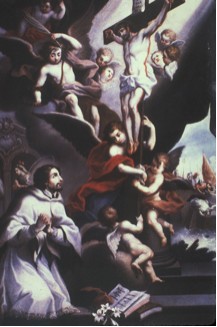
Guido Reni, "Penitant Magdelene" (Italy, 1626)
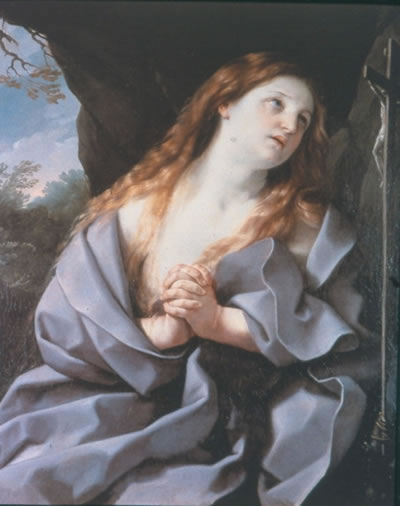
Detail, Guido Reni
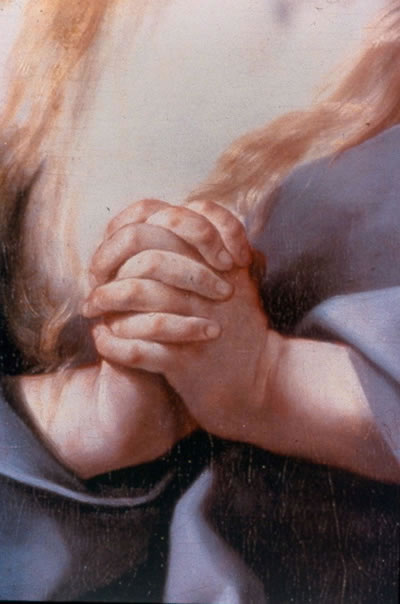
In Baroque religious art, the phrase "seeing is believing" takes on religious significance. Here, Mary Magdalene is painted meditating on the crucifix, and the viewer meditates upon her, painted with the typical Baroque combination sensuality and spirituality.
The Baroque painter strove to bring the supernatural into the realm of lived human experience. Scenes and figures were to be painted as realistically as possible in order to appeal to the senses--and to the emotions--of the viewer. The affective appeal--the sensuousness--of the image was crucial to devotional purposes, and also to educational and evangelical purposes--these last being particularly pressing in the Catholic New World. Thus, the realistic depiction of the visible world becomes a primary conduit to the invisible, flesh and blood a means of bringing the beholder into mystical communion with disembodied spirit.
This form of realism, with its transcendental view of reality, was brought wholesale to Latin America in the ships of the colonizers, and was produced throughout Latin America in richly transculturated forms during the entire colonial period--the Baroque extends far longer in Latin America than in Europe--well into the last half of the 18th century. But even in the very earliest European constructions in New Spain, scenes of human suffering and transcendence covered the walls. These murals in the Augustinian monastery of Epazoyucan, in the Mexican state of Hidalgo, are very early--mid-sixteenth-century—
Christ carrying the Cross, Epazoyucan, State of Hidalgo, Mexico, 16th century
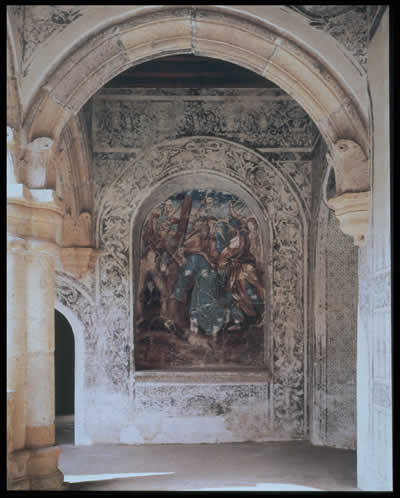
Death of the Virgin, Epazoyucan
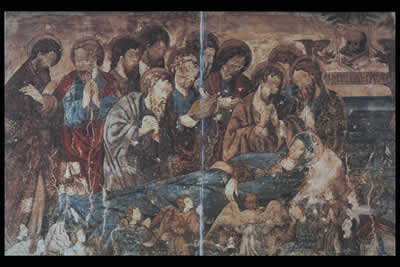
Detail, Lamentation of the Virgin, Epazoyucan
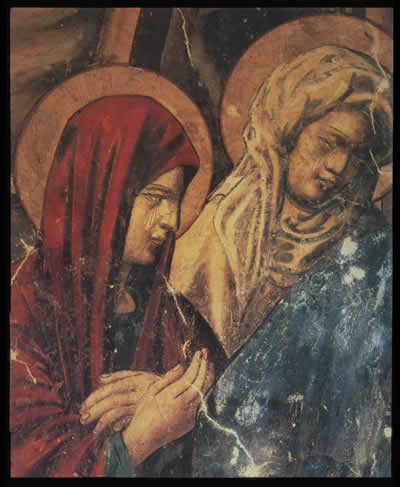
Detail, Lamentation of Christ, Epazoyucan
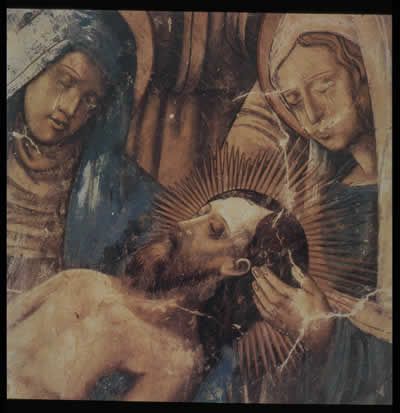
These are pre-Baroque in their style, but they predict the Baroque effusions that would follow. The theatricality of these Baroque scenes, in all their realistic detail, was designed to encourage the beholder to visualize the lives--and deaths--of Christ, the Virgin, the saints, the saved. Here, a painting by the 17th century Mexican painter Juan Tinoco, "The Lactation of St. Cajetan."
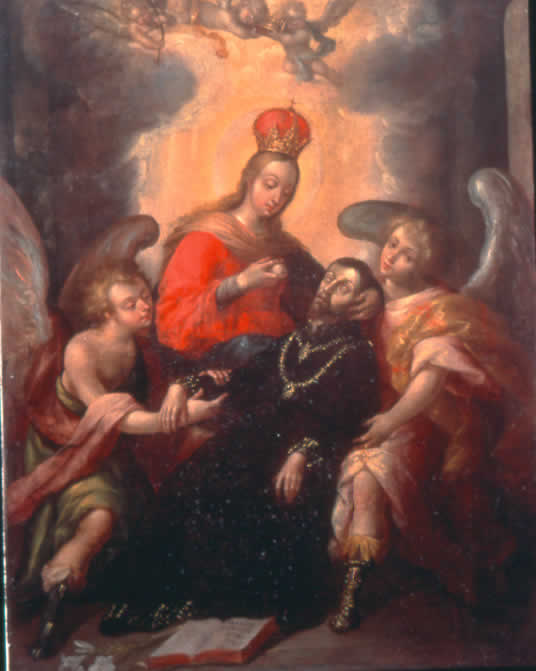
Here, we see Mary giving her milk to the swooning saint: the utter physicality of the divine is never in question, whether it is in academic painting or popular modes of expression.
Anonymous, Virgin of Milk, Peru, 19th century
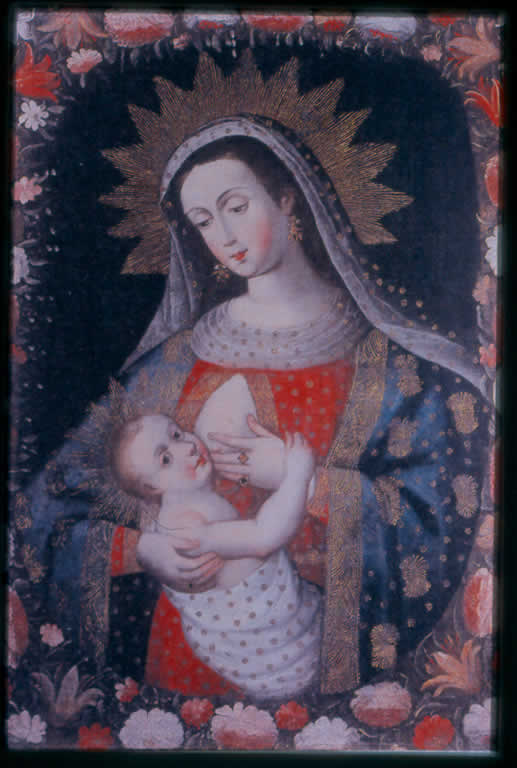
The analogy that I'm suggesting to García Márquez's fiction, then, is not that his work is religious or that it embodies Counter Reformation doctrine--far from it--but I am suggesting that his realism is Baroque in nature, and that the magic in his realism proceeds from a view of reality that is essentially Baroque. Consider García Márquez's characters, who are secular saints and martyrs and monsters in a Baroque mode. Consider he domestic excesses of José Arcadio, or the demonic excesses of the Patriarch, or the amorous excesses of Florentino, which are presented as examples of excessive suffering: Here, I suggest a painted analogue to Florentino's suffering.
José de Alzíbar, “St. Francis Xavier,” Mexico, 18th century
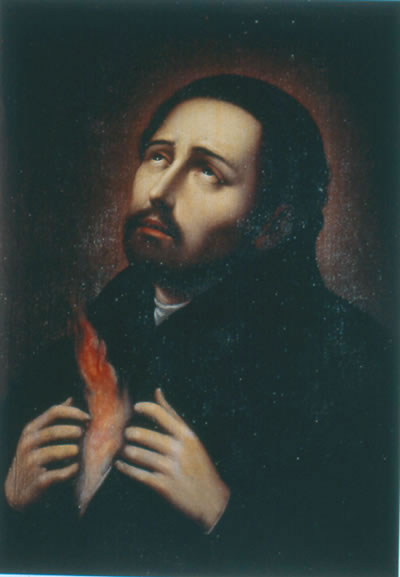
Divine and human love are often isomorphic in Baroque iconography, and equally torturous, as this 18th century Mexican painting of St. Francis Xavier suggests. Then, there the excessive beauty of Remedios the Beauty, who ascends to heaven as if she were modeled on one of the innumerable Baroque paintings of levitating figures: here, a series of soaring selves by José Ibarra, an 18th century Mexican Baroque painter.
Left to right, top to bottom: The Ascension; Pentacost; The Assumption of Mary; The Virgin of the Apocalypse
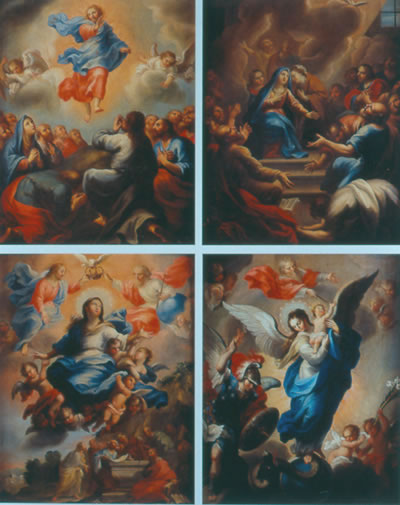
Or again, the epic insouciance of the García Márquez's very old man with enormous wings, who corresponds to any one--and all--of the vast flock of Baroque angels. Here, an old man with enormous wings is being skewered by a young man with enormous wings--the painting is "Saint Michael Arcangel," by the Mexican painter Luis Juárez; Juárez is much earlier than Ibarra, whose levitation series I just showed you; this painting is dated around 1620, and is still in a Mannerist mode, but its theatricality and naturalism predict the droves of Baroque angels and demons that would soon light in Latin America.
Luis Juárez, “Saint Michael Arcangel,” Mexico, 1620 ca.
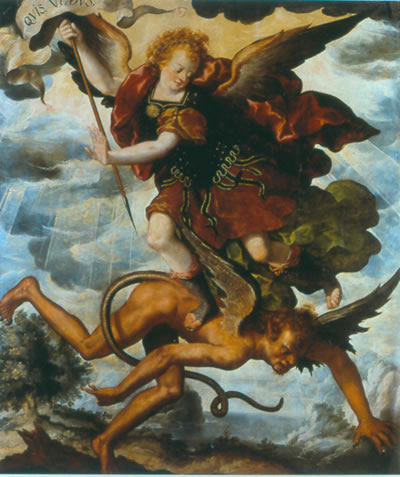
And then there is García Márquez's character Sierva María in his under-appreciated novel Love and Other Demons. Sierva María suffers the tortures of exorcism and love, and dies, it seems, from the combined effect of the two. She is the character to whom I referred earlier, whose hair continues to grow for two hundred years after her death, and whose desperation, along with her hair, resembles Mary Magdelene. Here is another rendition of La Magdalena, the converted prostitute who becomes Christ's best friend, who washes His feet with her hair, who suffers at the foot of the cross, is the first to find the tomb empty and who afterward becomes the great Baroque example of the penitent--in short, the saint who epitomizes the Baroque combination of eroticism and other-worldliness.
Alonso del Arco, 17th century Spanish, "Mary Magdalene Removing her Jewelry”
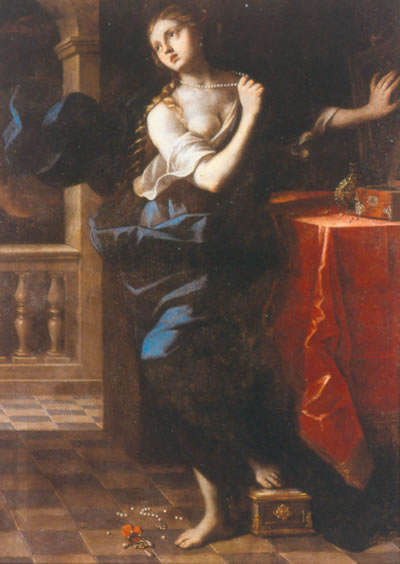
Baroque iconography counts upon specified objects to identify spiritual characteristics: the Magdalene is always shown with her long hair loose, her pearls, her bottle of perfumed oil that recalls her washing of Christ's feet and also the tears she has shed; here, a very different Magdalen, but we know it is she by her pearls and her bottle--magical realist objects a la Franz Roh, objects in which mystery hides and palpitates.
Caravaggio, “The Magdalene,” 1596
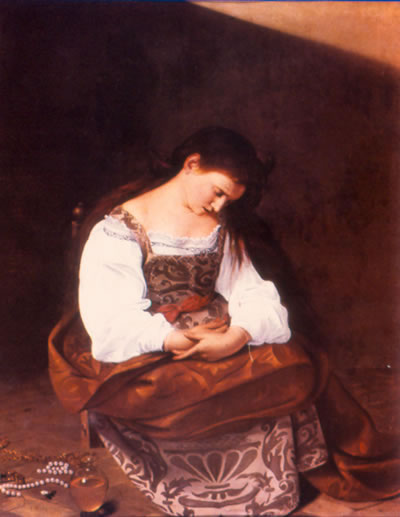
My point is this: each of these inordinate, Marquesian characters whom I have mentioned may be fruitfully considered in terms of the visual hagiographies of the Baroque period. The easy co-habitation of the divine and human in Baroque painting seems close indeed to the co-habitation of magic and real in García Márquez's fictional worlds.
But now, time to conclude--past time: We have seen that Borges and García Márquez are equally concerned with the relations of the visible world to invisible meanings, but García Márquez gives priority to the former, from which he infers the latter, whereas Borges proceeds in the opposite direction, starting with the invisible, from which he infers the world. For Borges, ideas precede objects and generate them, whereas for García Márquez, the object is the idea. García Márquez's Baroque aesthetics coincide with Franz Roh's avant garde aesthetics in their shared insistence on the invisible meaning inherent in visible artifacts, whereas Borges' idealizing strategies subvert the magic of the material world in favor of the magic of "secondary" objects that liberate him from the limitations of the real. Let's review our visual analogues:
Henri Rousseau's "The Dream" (1910):
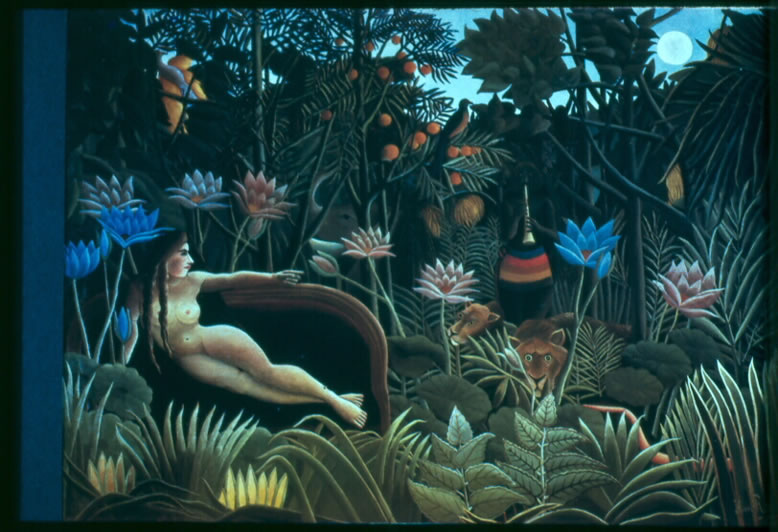
The objects in this Post-Expressionist paintings, with the inherent magic that Roh attributes to them, may be considered secular analogues to the Baroque interpenetration of human and divine, material and miracle,
José Juarez, "St. Augustine and Angel," (Mexico, 17th century)
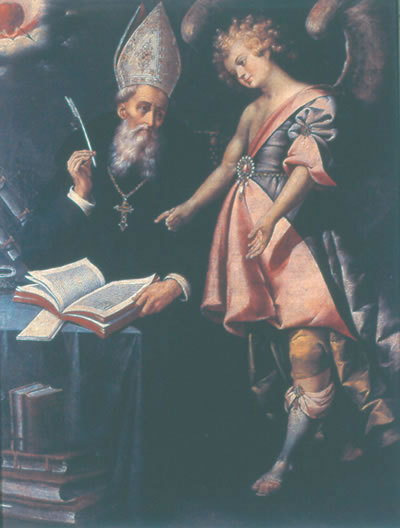
whereas Xul Solar's objects are abstracted and idealized in ways that propose them first as visualized ideas, and only secondarily as instantiations of the real.
Xul Solar, Unequal (Despareja)
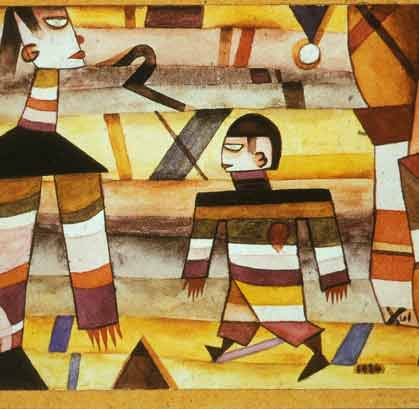
But, having made these distinctions, I want to say one more thing, and it is this: despite their great differences in style and substance, more unites Borges and García Márquez than separates them, for what they share is their investment in realism and its narrative modes. Both of these writers engage defamiliarizing strategies in order to renew their readers' appreciation of realism, and the real. How the many, sometimes-magical dimensions of the world can be visualized on the printed page is as urgent a question for Borges as it is for García Márquez, and as it surely is for the splendid array of magical realist writers whom we'll be hearing about here. Despite all the emphasis of recent literary criticism--my own included--on the magical aspects of the mode, magical realism has, in fact, revitalized realistic modes of narration. If magical realism is subversive of conventional narrative realism, conversely it also opposes the preference for abstraction--indeed, the aversion to realistic representation--characteristic of much twentieth-century art. In both of these ways at the same time, magical realism has revitalized the novel as an expressive form, and we can expect that it will continue to enrich our experience of literary realism, and reality, for some time to come.
